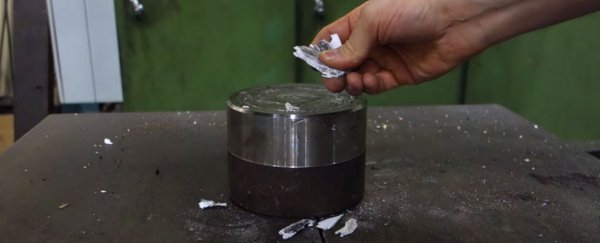
There's an old myth that you can't fold a single sheet of paper in half more than seven times, because each time you make a fold, the thickness of the paper doubles, and soon requires impossible amounts of energy to finish the crease. But thanks to an American high school student, Britney Gallivan, we now know that paper can be folded more than seven times, but not much more - Gallivan currently holds the world record for paper-folding at 12 folds in a single sheet of (toilet) paper.
Why is paper-folding so hard? As Dr Karl Kruszelnicki explains over at ABC Science Online, if you try to fold a standard A4 sheet of paper measuring about 300 mm long and 0.05 mm thick, you're going to run into some serious numbers pretty fast:
"The first time you fold it in half, it becomes 150 mm long and 0.1 mm thick. The second fold takes it to 75 mm long and 0.2 mm thick. By the eighth fold (if you can get there), you have a blob of paper 1.25 mm long, but 12.8 mm thick. It's now thicker than it is long, and, if you're trying to bend it, seems to have the structural integrity of steel."
In fact, if we take paper-folding to hypothetically great heights, the expanses we could cover become mind-blowing. Jesus Diaz from Gizmodo has reported some wild numbers:
- 30 folds will get you to space, because your paper will be now 100 km high.
- 42 folds will get you to the Moon.
- 81 folds and your paper will be 127,786 light-years, almost as thick as the Andromeda Galaxy.
- At 103 folds, you will get outside of the observable Universe, which is estimated at 93 billion light-years in diameter.
Paper-folding is ridiculous, we can at least say that. But let's get back to reality, and the number of folds we can conceivably make on Earth. The aptly named Hydraulic Press Channel on YouTube has attempted to fold an A3 piece of paper in half seven times using a hydraulic press to achieve the final folds, and let's just say the results are pretty weird.
Things go perfectly fine until we get to that infamous seventh fold. As the paper goes in, and the hydraulic press clamps down, we hear a "bang", and see that the paper has basically exploded into a hard, chalky substance that crumbles into pieces. It doesn't even look like paper anymore. So what just happened?
As Thomas Amidon, a professor of paper and bioprocess engineering at SUNY's College of Environmental Science and Forestry, told Mary Beth Griggs at Popular Science, the most likely explanation for the sad demise of the pressed paper wasn't the cellulose (wood) fibres it's made from, but another component of the paper: calcium carbonate.
This substance is added into the paper mix at the mill to make the finished product more opaque and stiff than it would be if composed of just wood fibres.
"You've probably heard of calcium carbonate before - it's a common mineral that is a building block of coral reefs and some forms of limestone," Griggs explains. "Amidon thinks that there was enough of the substance in the paper that when the high load of pressure from the hydraulic press was applied to the small area, the stress was just too much for the mineral, and it collapsed."
"It failed like a cement column," Amidon told her.
Watch the footage above to see the strange phenomenon in action. And if you want to learn more about the strange wonders of paper-folding, check out the video below, which will run you through the numbers of how to fold your paper so thick, it's as wide as the Universe:

